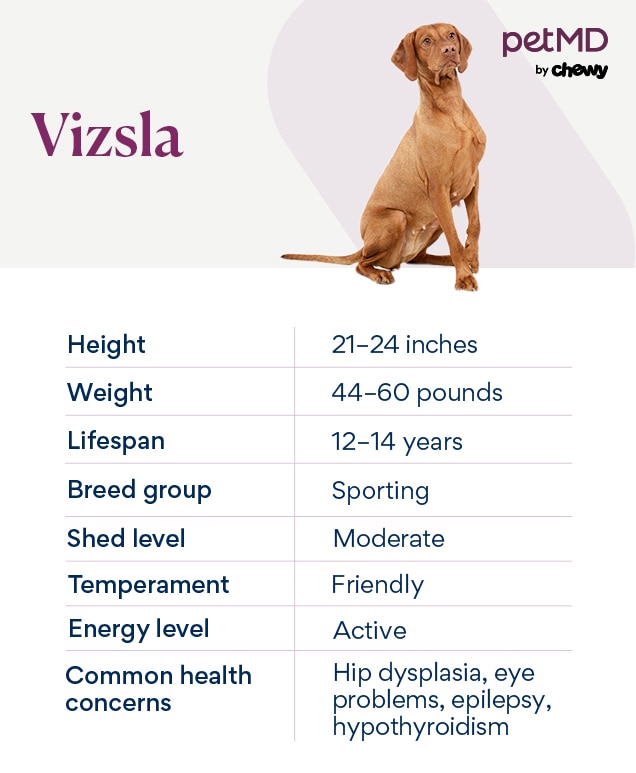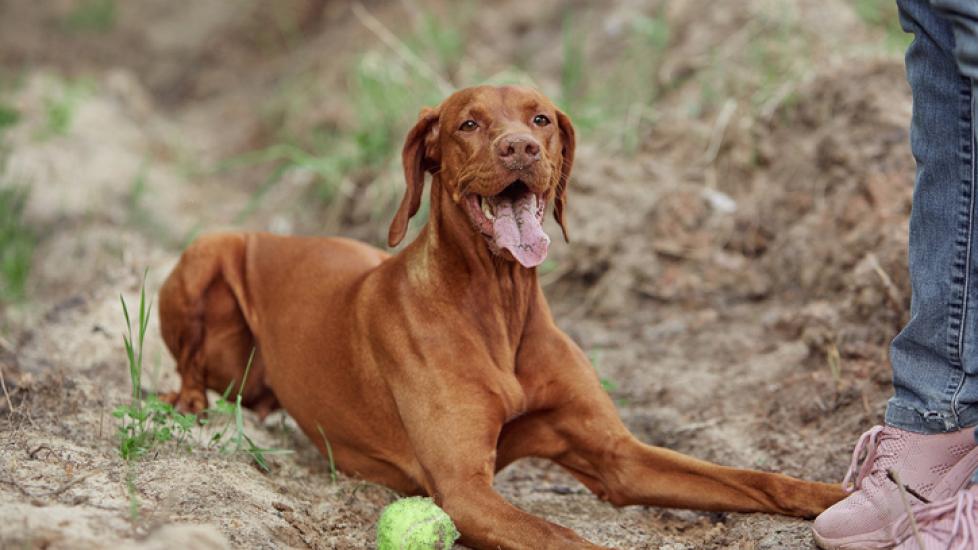Vizsla
The cheerful, energetic Vizsla was first bred in Hungary, where the breed was originally developed as a hunting companion. The prized athletes—named for the Hungarian word for “pointer”—have a smooth, red-golden coat, can weigh up to 55-60 pounds, and stand 22-24 inches tall. Because these pups adore time with loved ones, they are best for pet parents who are willing to establish a strong bond with their four-legged friend and ensure they receive plenty of daily exercise and affection.
Caring for a Vizsla

Hungarian Vizslas are considered one of the oldest-known hunting dogs, which means they are natural athletes that aim to please, according to The Vizsla Club of America. The high-energy, intelligent breed needs regular mental and physical stimulation, which can be everything from jogging and swimming to agility training.
These tall, long-eared beauties are extremely loyal and friendly, making them ideal family pets for households with children. But pet parents should be prepared to provide their Vizsla with plenty of room to roam and dedicate ample time to training them from a young age.
“Their strong energy levels make them unsuitable for apartment living and necessitate a roomy setting,” says Alex Schechter, DVM. “Vizslas prefer to live in homes with sizable gardens or easy access to green areas. They work best in houses with grown-ups and older kids. Children should always be under adult supervision when playing with dogs, regardless of the breed.”
The medium- to large-size dogs are very intelligent, and Vizsla puppies respond well to positive reinforcement training. To keep your pup’s beautiful coat looking her best, a rigorous grooming routine isn’t required, though regular brushing is recommended.
Vizsla Health Issues
The Vizsla dog breed is generally healthy and has an average lifespan of 10-14 years. That said, they are susceptible to some health issues. Pet parents can prevent these conditions by getting their puppy from a reputable Vizsla rescue or a breeder who responsibly tests their dogs.
Hip Dysplasia
Characterized by an abnormal growth or development of the hips, hip dysplasia is a common condition faced by medium- and large-breed dogs such as Vizlas. Larger dogs are more likely to develop hip dysplasia, which involves an unstable fit of the hip’s ball and socket joint. Pups with the condition commonly display reduced activity and limited mobility. There are many options for treating hip dysplasia depending on the severity, including nutrition supplements, weight management, anti-inflammatory and pain medications, and surgery.
Progressive Retinal Atrophy
PRA is an inherited disorder that causes the deterioration of the retina, a light-sensitive layer of cells in the eye, which can result in the gradual loss of eyesight. It isn’t a painful condition for Vizslas, though symptoms include night blindness, sensitivity to bright light, and dilated pupils. While there is no treatment for PRA, it can take months or years for the disease to cause blindness.
Hypothyroidism
Hypothyroidism is a condition in canines characterized by the decreased production of hormones in the thyroid gland. Like in humans, this gland serves an important function in dogs’ metabolism. If the organs aren't producing enough hormones, body functions slow, resulting in symptoms such as weight gain, lethargy, chronic skin and ear infections, and an unhealthy coat. If left untreated, hypothyroidism can shorten your Vizsla’s lifespan. But thankfully, the condition can be treated with a lifelong oral medication.
Epilepsy
Dogs with epilepsy have recurring seizures that are caused by abnormal, involuntary electrical activity in the brain that can be sporadic and mild to frequent and severe. Seizures can take many forms, but dogs experiencing a generalized seizure may:
-
Fall down
-
Unintentionally urinate and/or defecate
-
Stretch out their legs
-
Become unaware of their surroundings
-
Have difficulty walking
-
Be confused
-
Display abnormal behavior
-
Have tremors or convulsions
While seizures are unsettling for pet parents and can be life-threatening in certain cases, many dogs with epilepsy live long, happy lives—if they receive prompt and appropriate care from a veterinarian.
What To Feed a Vizsla
To help your Vizsla maintain a healthy weight, avoid health conditions, and be her happiest, she must consume the proper amount of high-quality dog food approved by the Association of Animal Feed Control Officials (AAFCO) and have access to fresh water.
How To Feed a Vizsla
Ivana Crnec, DVM, recommends an age-appropriate diet that is complete and balanced for your Vizsla. One thing to keep in mind when feeding a Vizsla is that they’re susceptible to bloat due to their deep-chested body. “To prevent this potentially life-threatening condition, use a slow-feeder bowl or snuffle mat,” Crnec says. “Also, avoid exercise immediately prior to and after mealtime.”
How Much Should You Feed a Vizsla?
To determine the appropriate quantity of food to give your Vizla, talk to your veterinarian. They will assess your pup’s age, activity level, and other factors to determine how many calories your dog needs to consume daily. It's crucial to keep an eye on your dog's weight and modify it as necessary.
“Vizslas should reach adulthood weighing between 40-65 pounds,” Schechter says. “Speak with your veterinarian if you have any worries about the weight or diet of your dog.”
Nutritional Tips for Vizslas
Treats should only make up 10% of your dog’s calorie intake and never replace their commercial food diet, according to the Pet Food Institute. Vizslas fed a complete and balanced diet shouldn’t need any nutritional supplements (unless they’re recommended by a veterinarian), so be sure to invest in a food catered to your dog’s life stage (puppy, adult, or senior).
Essential nutrients in dog food include carbohydrates, vitamins, minerals, fat, and protein, the right combination of which will help your tail-wagging companion maintain a healthy energy level and look and feel her best.
Behavior and Training Tips for Vizslas
Vizsla Personality and Temperament
If you prefer lounging on the couch to heart-pumping activity, a Vizsla isn’t a good match for you. According to the Vizsla Club of America, a Vizsla needs at least seven hours of exercise per week and relishes activities such as walking, jogging, running, or swimming. That means pet parents who love being outside are the best companions for Vizslas.
Vizslas are loyal canines that adore other members of their pack. They can be gentle and affectionate with children and live contentedly with other dogs and even cats, though proper (and early) socialization is essential. And remember: Pet parents should ensure that children and pups are always supervised during play, regardless of the breed.
“The Vizsla is an affectionate dog that gets along well with children and is patient and understanding,” Schechter says. “But for small children under the age of 6, [a Vizsla’s] excitement can be too much.”
Vizsla Behavior
Because they love to stick by their pet parents at all times, Vizslas have been nicknamed “the Velcro dog.” As a result, they’re sensitive pups that require consistent positive training and caregiving. They love problem-solving, and if they’re not given ample amount of attention, the pups are prone to boredom, which can result in undesirable behavior such as chewing or getting into closets and cupboards.
The Vizsla Club of America notes that the best pet parents provide jobs for their dogs, such as obedience, agility, and field tests. Because of their curious natures, Vizslas shouldn’t be left unsupervised. Crate training is recommended to keep their mischievous tendencies at bay, particularly when you’re not home.
Vizsla Training
Vizslas are known for their intelligent and easy-to-train natures, and they have been trusty hunting companions for centuries. “They are both very intelligent and eager to please—a combination that results in easy trainability,” says Crnec. “Positive reinforcement is the best training approach. Considering the Vizsla’s size and pulling strength, I suggest paying extra attention to leash training.’
Positive reinforcement is a training method that involves using praise and treats to reward good behaviors, and it should start as early as possible in your Vizsla puppy’s life. Because Vizslas are also a sensitive breed, they require the care of a patient pet parent who is willing to commit to a calm and consistent training schedule.
Fun Activities for Vizslas
-
Hunting
-
Walking or running
-
Hiking
-
Frisbee
-
Swimming
-
Dock diving
-
Tug-of-war
-
Agility training
Vizsla Grooming Guide
The Vizsla is blessed with a short, red-golden coat that requires only basic care: an occasional bath and brushing. To minimize the risk of periodontal disease, brush your dog’s teeth regularly using a dog-specific toothbrush and toothpaste.
“A good grooming routine for the Vizsla is integral to keeping them healthy and happy. With regular brushing, bathing, trimming, and checking of eyes, ears, and teeth, all it takes is a little effort to keep your Vizsla looking great and feeling [her] best,” says Michelle Lehr, CCMT, a canine massage therapist and nutritionist.
Skin Care
Vizslas don’t require a regular bathing routine, but your adventure buddy may sometimes benefit from a wash in the shower or tub, particularly if they get wet or dirty outside.
Coat Care
The Vizsla breed does not require a lot of grooming, but Lehr recommends establishing a regular brushing routine, as the Vizsla’s gorgeous rust-hued coat is still prone to shedding and matting.
“Regular brushing not only helps reduce shedding and matting, but also helps to improve
circulation and spread natural skin oils throughout the fur,” she says. “A slicker brush and a pin brush are both good choices for brushing a Vizsla and should be used at least once a week.”
Eye Care
Because congenital eye conditions—such as progressive retinal atrophy—are a common condition in Vizslas, pet parents should also look for symptoms, such as impaired night vision, light sensitivity, and dilated pupils.
Ear Care
Vizslas are prone to ear infections, so it’s important to keep a close eye on your pet’s ear hygiene and clean their ears regularly, particularly during and after bath time and if your pup goes for a swim.
Considerations for Pet Parents
The cheerful, athletic Vizsla is a wonderful companion for active pet parents who enjoy spending time in the great outdoors. Those who bring a Vizsla home should be prepared to provide them with at least one hour of exercise per day. Though they can live in smaller quarters when given an ample amount of physical stimulation, larger homes are more suitable for the graceful, sporty pups.
While the breed is eager to please and highly trainable with positive reinforcement methods, the dogs have a sensitive nature and require the attention of a patient and doting caretaker. Vizslas that receive consistent training from a young age and are properly socialized can grow into affectionate family dogs.
“The Vizsla is an energetic dog breed with go-all-day stamina. [She] also enjoys being mentally stimulated and challenged,” Crnec says. “The Vizsla is great with children and gets along well with other dogs. [She’s] gentle and affectionate with family members.”
Vizsla FAQs
How much are Vizsla puppies?
The average cost of a Vizsla puppy can range from $1,000-$1,800, depending on the source, lineage, location, and other factors. Pet parents who want to invest in a Vizsla puppy should also consider the costs of care, including vet visits, training, and food.
How long do Vizslas live?
The average lifespan of a Vizsla is 10-14 years.
How large do Vizslas get?
Vizslas are lean medium- to large-size dogs that stand up 22-24 inches tall. Like most other dog breeds, females are typically smaller than males.
What were Vizslas bred for?
The Vizsla breed is likely descended from 8th-century Hungarian hunting dogs. They have been pictured in stone etchings alongside a hunter and a falcon, according to the Vizsla Club of America. Over the centuries, they evolved from the companion dogs of early warlords and barons to coveted pets of Hungarian nobles. At the end of World War II, the Vizsla started arriving in the United States, where the breed is still known as a prized hunting buddy, graceful athlete, and devoted family member.
Featured Image: iStock/Natalia Miachikova
